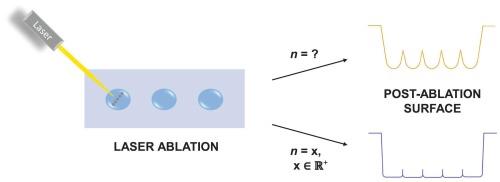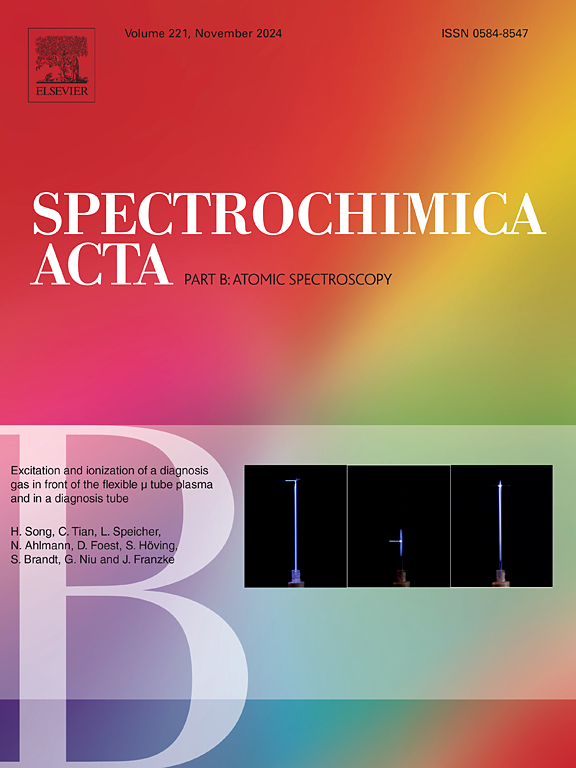Enhancing laser ablation inductively coupled plasma mass spectrometry analysis through empirical modeling of crater geometry
IF 3.8
2区 化学
Q1 SPECTROSCOPY
引用次数: 0
Abstract
Laser ablation inductively coupled plasma mass spectrometry (LA-ICP-MS) systems are engineered to produce uniform, flat-top beam profiles for optimal surface sampling. In practice, however, rounder beam profiles are prevalent. Their geometrical characteristics can be mathematically described using the two-dimensional super-Gaussian or even a Gaussian function for smaller beam sizes, with the super-Gaussian factor (n) serving as a quantifier. Since the beam profile and the ablation grid have a direct influence on the amount of sampled surface material, the idea is to reduce the ablation grid by sub-pixel mapping to improve the accuracy of surface scanning, increase pixel density, improve spatial resolution, and increase signal-to-noise ratio (SNR). This paper explores the relationship between super-Gaussian order (n), beam size, and laser fluence for circular beams, using two laser ablation systems with different wavelengths – 193 nm and 213 nm nanosecond lasers. An empirical model was developed to yield the factor n, facilitating the determination of the contraction factor (k). Identifying the precise contraction factor for each beam size brings the beam profile closer to a flat-top shape, producing smoother post-ablation surfaces and enhancing image quality due to heightened pixel density. Ultimately, such models improve our understanding of crater geometry optimization, leading to better analytical outcomes in LA-ICP-MS analysis.

通过陨石坑几何形状的经验建模增强激光烧蚀电感耦合等离子体质谱分析
激光烧蚀电感耦合等离子体质谱(LA-ICP-MS)系统设计用于产生均匀的平顶光束轮廓,以获得最佳的表面采样。然而,在实践中,更圆的光束轮廓是普遍的。它们的几何特征可以用二维超高斯函数或者更小光束的高斯函数进行数学描述,其中超高斯因子(n)作为量词。由于光束轮廓和烧蚀网格对表面材料的采样量有直接影响,因此我们的想法是通过亚像素映射来减少烧蚀网格,以提高表面扫描的精度,增加像素密度,提高空间分辨率,提高信噪比(SNR)。本文利用两种不同波长的激光烧蚀系统——193 nm和213 nm纳秒激光器,研究了圆光束的超高斯阶数(n)、光束尺寸和激光通量之间的关系。开发了一个经验模型来产生因子n,便于确定收缩因子(k)。确定每个光束尺寸的精确收缩系数,使光束轮廓更接近平顶形状,产生更平滑的烧蚀后表面,并通过提高像素密度提高图像质量。最终,这些模型提高了我们对陨石坑几何形状优化的理解,从而在LA-ICP-MS分析中获得更好的分析结果。
本文章由计算机程序翻译,如有差异,请以英文原文为准。
求助全文
约1分钟内获得全文
求助全文
来源期刊
CiteScore
6.10
自引率
12.10%
发文量
173
审稿时长
81 days
期刊介绍:
Spectrochimica Acta Part B: Atomic Spectroscopy, is intended for the rapid publication of both original work and reviews in the following fields:
Atomic Emission (AES), Atomic Absorption (AAS) and Atomic Fluorescence (AFS) spectroscopy;
Mass Spectrometry (MS) for inorganic analysis covering Spark Source (SS-MS), Inductively Coupled Plasma (ICP-MS), Glow Discharge (GD-MS), and Secondary Ion Mass Spectrometry (SIMS).
Laser induced atomic spectroscopy for inorganic analysis, including non-linear optical laser spectroscopy, covering Laser Enhanced Ionization (LEI), Laser Induced Fluorescence (LIF), Resonance Ionization Spectroscopy (RIS) and Resonance Ionization Mass Spectrometry (RIMS); Laser Induced Breakdown Spectroscopy (LIBS); Cavity Ringdown Spectroscopy (CRDS), Laser Ablation Inductively Coupled Plasma Atomic Emission Spectroscopy (LA-ICP-AES) and Laser Ablation Inductively Coupled Plasma Mass Spectrometry (LA-ICP-MS).
X-ray spectrometry, X-ray Optics and Microanalysis, including X-ray fluorescence spectrometry (XRF) and related techniques, in particular Total-reflection X-ray Fluorescence Spectrometry (TXRF), and Synchrotron Radiation-excited Total reflection XRF (SR-TXRF).
Manuscripts dealing with (i) fundamentals, (ii) methodology development, (iii)instrumentation, and (iv) applications, can be submitted for publication.

 求助内容:
求助内容: 应助结果提醒方式:
应助结果提醒方式:


